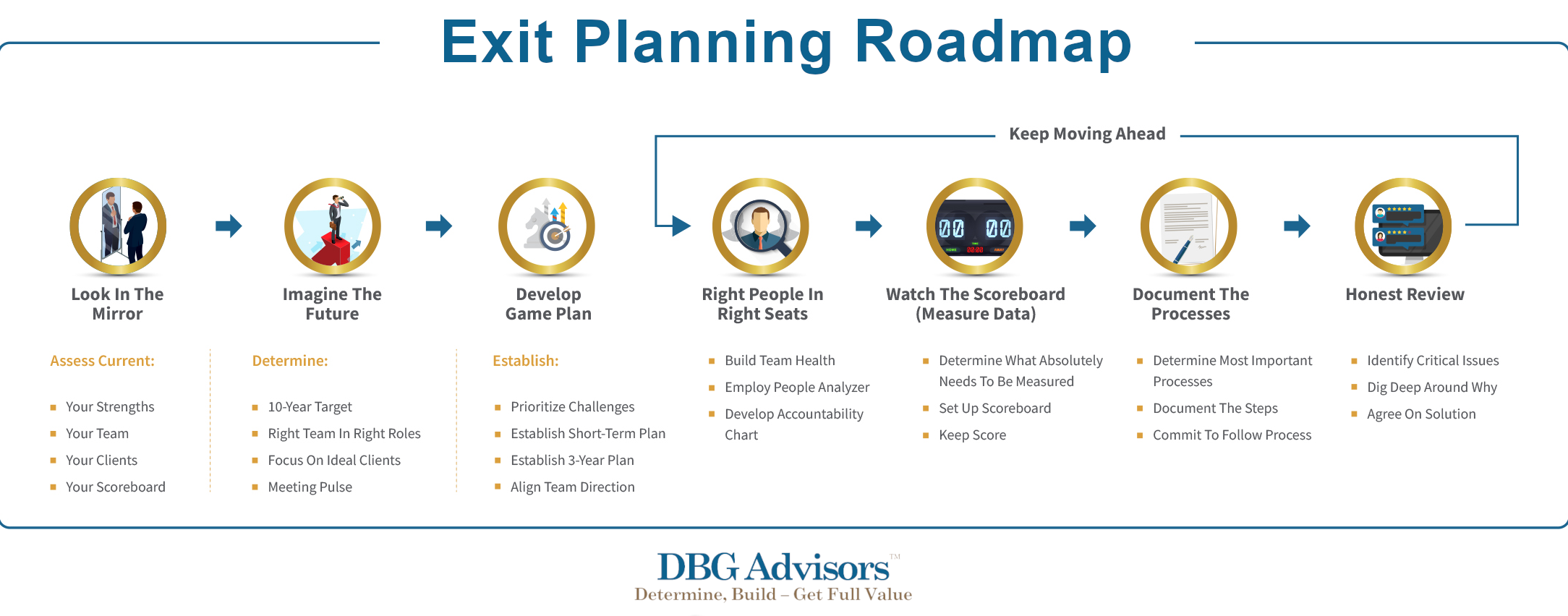Many business owners wake up one morning and think to themselves, “I should sell my business!” Deciding to sell is easy. Making sure that you are ready to sell is another matter altogether. Chances are, this is your first time selling a company. The problem is there are many issues between the thought and the action of selling your business that can derail your dreams along the way.
DBG Advisors specializes in guiding business owners through a process that will increase the value of their company and increase their chances of Getting Full Value when they sell.
We guide business owners using our Build-To-Sell or Exit Strategy Roadmap. This roadmap puts clients into the best position when they decide to pull the trigger and sell their company. Creating an exit strategy can take as little as one year to complete. although in some cases it has taken longer. With that said, no matter how long it takes it will be well worth the time when the value of your business is significantly improved.


Look In The Mirror
The first thing we must do is assess the company’s current position. We need to take a good look in the mirror and really see what is there. This could be seen as a SWOT analysis, but it is geared to your team, your clients and to who you are as a business owner.
Your strengths. We look at the financials; review the operations; examine the policies & procedures; evaluate how the company drives value to the bottom line; and discuss marketing practices.
Your team. Determine the team’s strengths by using the Core Values Index to reveal each team members individual core values. If each team member is honest with themselves, they can begin to understand their highest and best use in the company. Dr. Nolan Duck is a Certified CVI Coach.
Your clients. We help our clients determine if the clients they have are “ideal clients” or if they should rethink who their target market is. There are times when business owners are unwittingly focused on the wrong demographic.
Your Scoreboard. What are you using to keep score? In any game the scoreboard lets the team quickly see who is winning or losing. If the company’s leadership team cannot possibly win if they do not know how to keep score.

Imagine The Future
Taking steps to grow your company begins with imagining the future in a realistic way. Business owners need to take a few steps back and look at their business objectively and re-imagine the future
Ten Year Vision. Look at your company the way a buyer would and establish long range, energizing goals for the company. This not only rejuvenates you it also invigorates the current leadership team and gives everyone a vision of the future.
Right Team in Right Roles. Building on what the team discovered in the Core Values Index exercise the leadership team can begin to recognize their value to the team and the role that they should be playing.
Focus on Ideal Clients. Reevaluate your current clients and ask, “Are these clients Ideal Clients?” If they are not Ideal Clients, then refocus your attention on reaching those prospects who would be Ideal Clients for your business.
Meeting Rhythm. Establish a weekly meeting with a specific agenda designed to help you stay focused on what is important, solve issues effectively, and keep the team connected. Establish all-day Quarterly Meetings and an Annual two-day Meeting to keep the focus on the future.

Develop A Game Plan
Without a game plan the team will faulter. The Bible says it this way, “Where there is no vision, the people perish.” If there is no game plan or if the game plan the team is using is ineffective then it is time to develop a new one.
Prioritize Challenges. There are hundreds of challenges that flood into any business every month. There is no way to deal with all of them but if the team will take some time to prioritize these challenges then they can become manageable and progress can be made.
Establish Three Year Focus. Define what your company will look like, feel like, and be like in three years. The Three Year Focus creates a powerful image of the future and helps everyone work towards the same vision.
Establish a 1-Year Plan. Outline your objectives for the year by identifying and crystallizing your revenue target, profit target, and measurables, along with your top three to seven goals. Develop SMART Goals which are Specific, Measurable, Attainable, Realistic, and Timely.
Align Team Direction. The Three Year Picture and 1-Year Plan will order the steps of the entire team so that everyone is operating out of the same playbook as they follow the game plan.

Right People In Right Seats
John Maxwell says, “Everything rises or falls with leadership.” This is true and having the right people in the right seats on the bus makes all the difference if you want to get to the right final destination.
Build Team Health. If the company is going to preform properly then everyone needs to be healthy and able to plan their role. Team health has both individual and group applications. The team needs to be able to operate in an open and honest atmosphere so that everyone can identify, discuss, and solve the issues that come up without fear of repercussions.
Develop Responsibility Chart. This chart clarifies responsibility for the company. Different from an organizational chart, a responsibility chart defines the right structure for your company and clearly identifies who is accountable for what.
Employ Team Survey . This is a simple tool that pulls your Core Values and Responsibility Chart together to help your organization identify if they have the Right People in the Right Seat.

Watch The Scoreboard (Measure Data)
Without a Scoreboard, no one knows who is winning the game. Scoreboards show us how well or how poorly we are doing. Sometimes business owners are so busy keeping up daily demands that they do not take time to look at the scoreboard. This is a deadly mistake.
Determine What Absolutely Needs to Be Measured. Measured results are important if you want to know if you are winning or losing. Business owners do not need to measure everything, but they do need to measure the important metrics. Owners need to determine and then measure what is important to develop an effective scoreboard that measures success or failure.
Set Up Scoreboard. These important measurements need to be set up in such a way that it is easy to evaluate success or failure with a quick glance. Tracking a handful of numbers that give you a pulse on your business is all that is needed. However, these numbers need to be easily seen by the leadership team.
Keep Score. Having a scoreboard is one thing, keeping score is another. If the team never looks at the score or if they never really care about what the score is then the company is headed toward failure. Knowing the score and allowing the score to make a difference in the behavior of the team is very important.

Document The Process
Systemizing your business by identifying and documenting the core processes that define the way to run your business increases the success and the value of the company. This process, while sometimes tedious, is well worth the effort because it provides clarity and ultimately value when you go to sell your business.
Determine Most Important Processes. Every process does not have to be documented; however, the most important processes do need documentation. Accounting, marketing, sales, operations, and human resource processes may be important to your business but identifying your handful of cores processes is key.
Document the Steps. This can be done by using a Process Documentation method. 1) Give each process a name that everyone agrees upon, 2) record the major steps in each core process, and 3) package each core process in a way that is easy to find.
Commit to Follow Process. All the work above will not benefit anyone unless the leadership team and the whole company make a commitment to follow the process. This will require training, supervision, accountability, and a commitment to fellow team members. This commitment will lead to success on multiple levels within the company.

Honest Reviews
Open and honest evaluation on a regular quarterly basis is an important component to the success of the business. Everyone wants to be successful, but few will take the time and make the commitment to be successful. Honest review moves any business further down the path of success.
Identify Critical Issues. Strengthening your company’s ability to identify issues can only take place if there is interpersonal transparency within the leadership team. When team members are afraid of looking bad, they will often ignore issues that are damaging to the business to “keep the peace” and not bring up issues that may produce conflict. Ultimately, conflict is our friend, and everyone needs to be able to speak freely to help the company identify real issues that are damaging.
Dig Deep Around Why. Once an issue has been identified then the whole team needs to openly discuss the reasons that may be causing the problem or issue. This can be done within the context of a “healthy” team that is seeking to address the issue on the way to solving the issue forever. Sometimes this can take some time but if a company is going to be successful then it is time well spent.
Agree on Solution. Several different solutions to the issue might be discussed by the leadership team but in the end, the team needs to agree on the solution. A healthy team will walk out of a discussion session with a commitment to one way to solve the issue. This not only builds the team it builds the morale of the entire company.
 The DBG Proven Sales Process
The DBG Proven Sales Process
Most business owners know everything about their business. They know the good, the bad and the ugly. They understand the ins and outs of the industry. They live with the ups and downs, day in and day out.
However, few business owners have ever sold a company. Selling a business follows a unique process for a sale to be successful. However, business owners don’t know what they don’t know.
Business owners need to work with a professional M&A Advisor who understands the sales process. Owners, not only do you need to know what to do and when to do it along with what not to do. Every decision has consequences and experience will help provide positive results.
An M&A intermediary can provide guidance throughout the process, from business valuation to promotion, negotiation to coordination with transaction attorneys and CPAs.
Owners need to plan for how they want to walk away from their business, not only in a perfect scenario but also in a worst-case scenario. It is critical to consider the following situations that force owners to exit their business hurriedly, that could leave value on the table. These situations are often called the 5 D’s:
- Death – of business owners/partner
- Disability – of the owner(s),
- Divorce – of the owner(s),
- Disagreement – between owners
- Distress – outstanding debt and liabilities
DBG Advisors specializes in the sale of manufacturing, distribution, and service companies. We follow a Business Sales Roadmap that has led to many successful M&A transactions.

